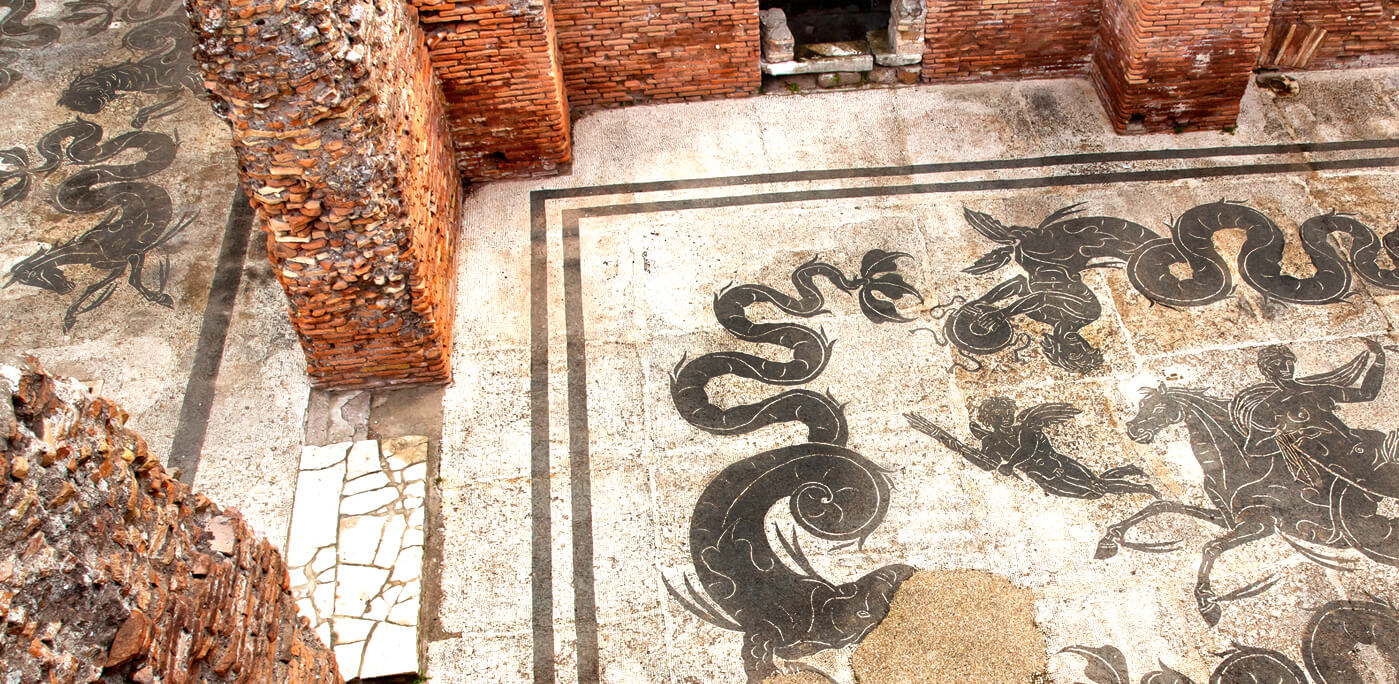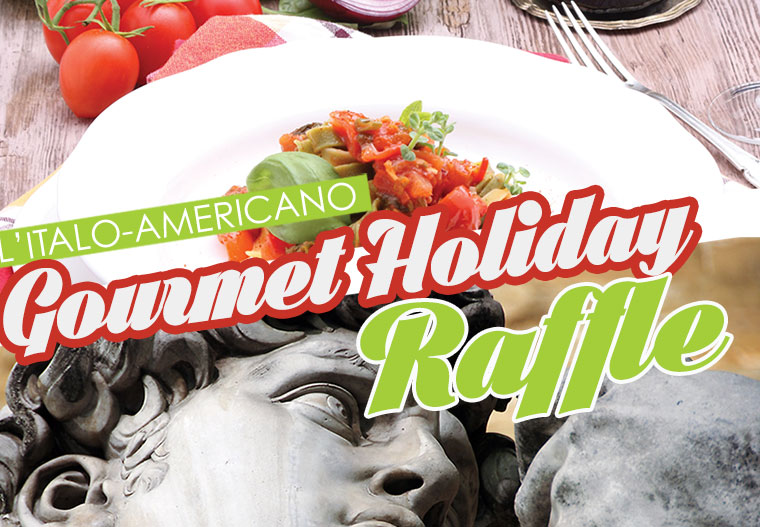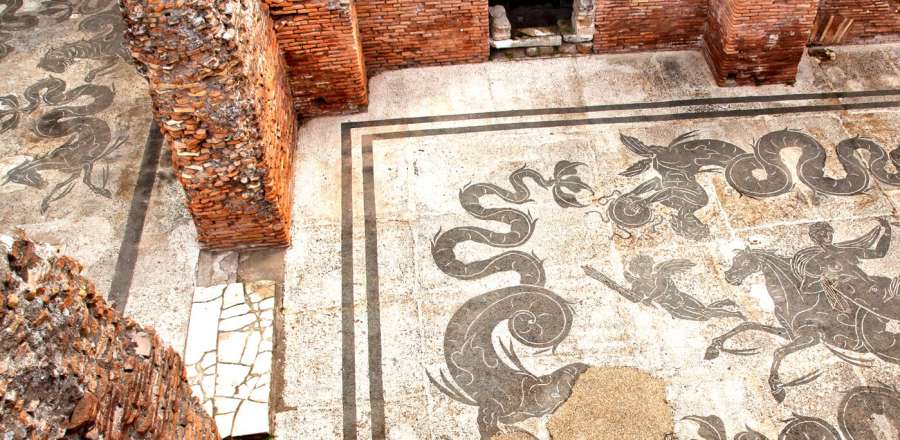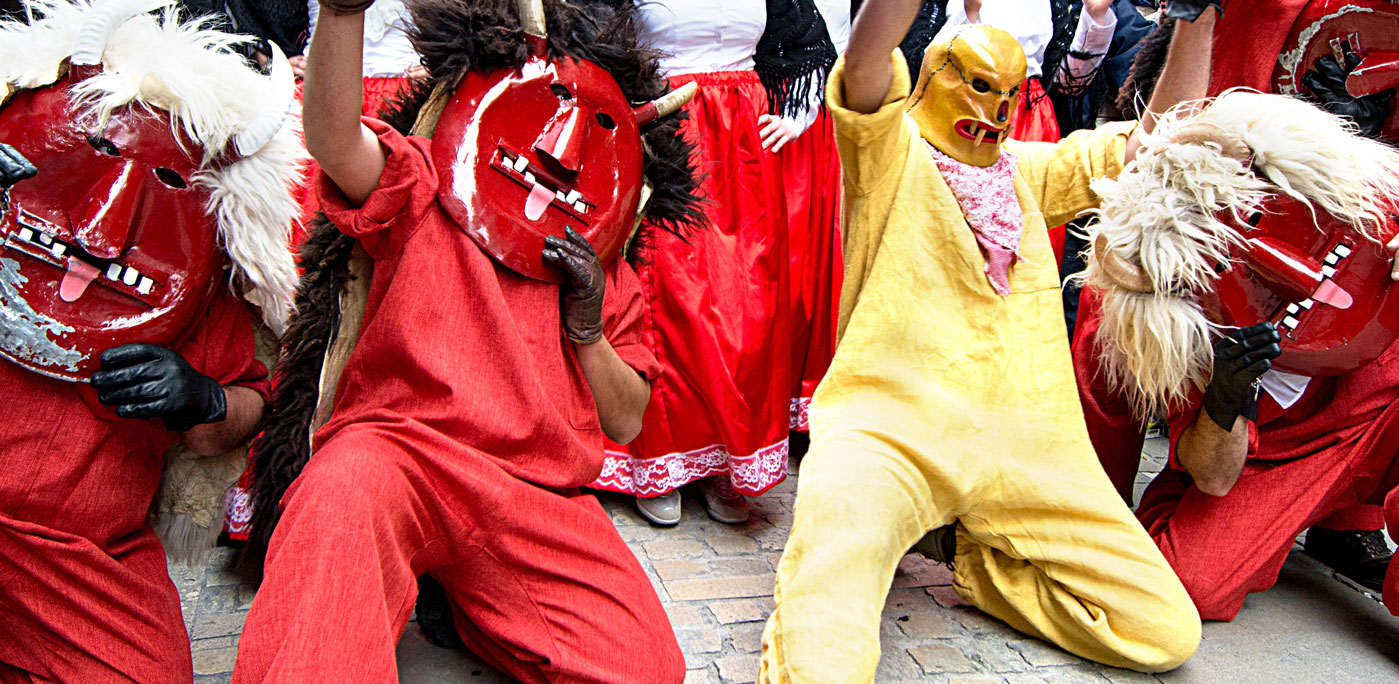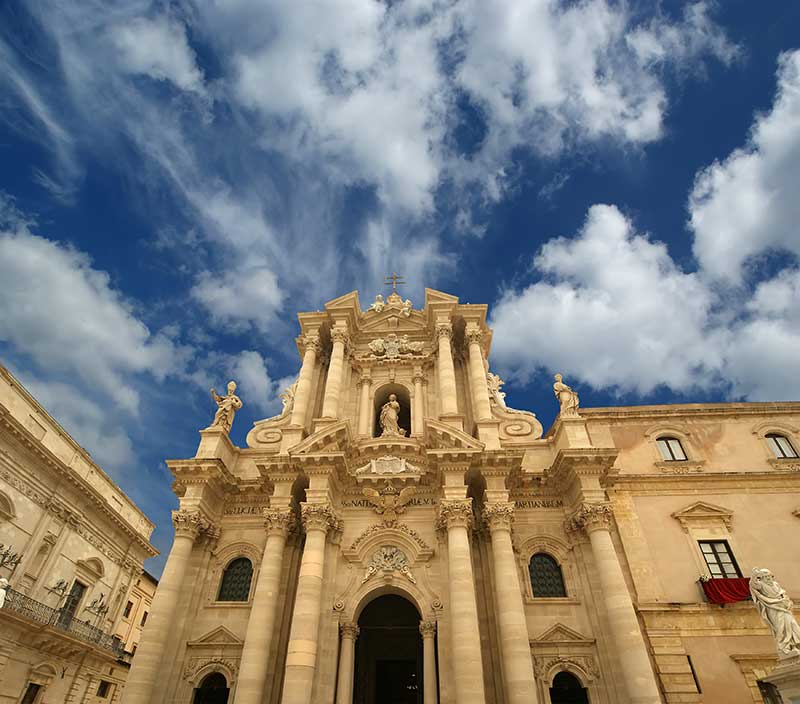Over two and a half million visitors flock annually to Pompeii to marvel at the ancient Roman city caught in time. But just half an hour outside Rome sits another well-preserved ancient Roman city, all but deserted but just as fascinating. Instead of the volcanic dust that enveloped Pompeii and neighbouring Herculaneum near Naples, the coastal city of Ostia Antica simply silted up after the fall of the Roman Empire, surviving down through the centuries covered in a thick layer of mud. Today its streets, shops, amphitheatre and houses are silent except for the incessant buzz of cicadas; let’s take a stroll back through time to explore this ancient treasure.
The origins of Ostia Antica
Legend suggests that Ostia Antica may have been one of Rome’s first military outposts, founded around 620 BC, the just over a century after Rome itself. The town was perfectly positioned to guard the mouth of the River Tiber leading up into Rome against seaborne invasions. And indeed the town takes its name from its coastal location, as the Latin for mouth is “os” which became “ostium.”
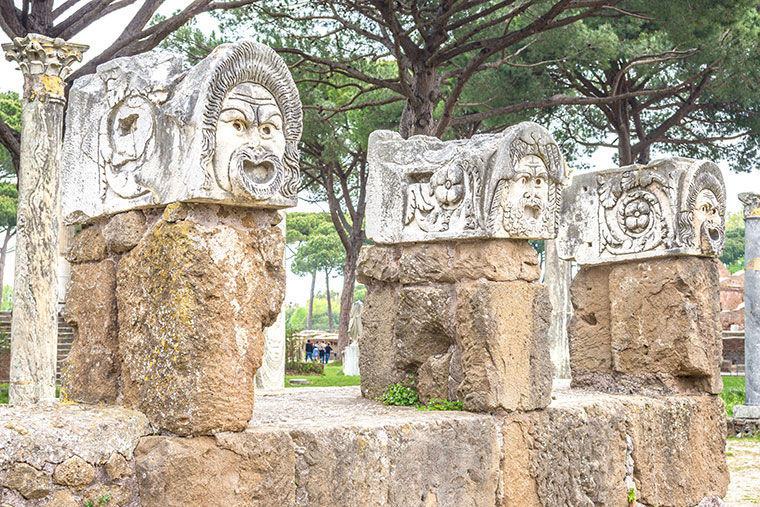
Details of roman mask sculpture, probably decoration of the theater in the old town of Ostia, Rome, Italy, today mounted on what remains of the wall of the scaena.— Photo by fbxx
As Rome grew in size, the city needed more and more provisions to feed its people. The easiest cargo route into the Eternal city was along the River Tiber turning Ostia into an enormous domestic and commercial harbor for Mediterranean merchant ships. By 100 AD Ostia Antica was a thriving, bustling city and home to over 100,000 people from all over the ancient Roman Empire including Nubians, Syrians, Gauls, Greeks and Egyptians. Surviving frescos and statues also show that the city was multi-faith too with one of the oldest synagogues and worshippers from all over the known world.
Gradually over time Ostia built its wealth on trade. In the early years the main cargo was grain – the staple for flour, bread and beer – from Sicily, Sardinia and Egypt. But as the Roman Empire expanded the goods coming through Ostia expanded too. At its height ships were bringing in wine from Bordeaux, horses and metals from Cadiz, silk and spices from the Silk Road to China and the treasures of Greece. It was vibrant and atmospheric.
And not only did Ostia draw in all nationalities, the cosmopolitan port also attracted people from all walks of life including merchants, sailors, traders, warehouse owners, slaves, rope-makers, porters and customs officers. Not to mention tavern owners, shopkeepers and ladies of the night who made the city livable. And it’s the daily life of shops, houses, baths and theatres that we see preserved in the meadows between the Tiber and Tyrrhenian Sea today. It makes for a fascinating visit.
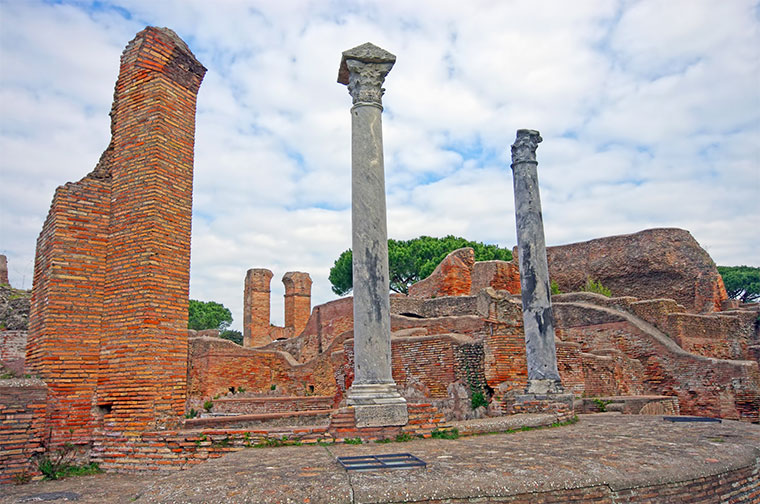
Roman ruins at Ostia Antica, near Rome— Photo by savacoco
Ostia Antica today
Today Rome’s ancient port of Ostia Antica still sprawls over around 10,000 acres of countryside but it fell silent centuries ago after the fall of the Empire. Fortunately, the city wasn’t buried in volcanic mud like Pompeii, but the gentle silting up of the River Tiber gradually moved the shoreline away from the city covering and land locking it over 2 miles from the sea and condemning it to history.
Over the years grass and trees took over with local shepherds using the ruins as grazing or shelter for their sheep. Luckily the mud that eventually buried the harbor also managed to protect it from the worst medieval scavengers looking for stone to build their houses. So today you can take a leisurely stroll through the ruins, exploring the classic Roman grid street system that dates back more than 2000 years to its military foundation.
And without the crowds and dust of Pompeii it’s much easier to let your mind wander in this atmospheric place imagining how daily life might have been. From the bakery to the fishmongers, from the bars, restaurants and public toilets to the town square or spectacular amphitheatre, every stop elicits images of a rich, bustling port life. Add in the public baths, early shopping arcades, houses, apartments and warehouses and you have all the ingredients for a wonderful day trip time travelling back to the days of the ancient Romans.
But it’s the exquisite detail and decoration in Ostia Antica’s mosaics that really bring the city to life.
Wandering around the ruins, entering streets and courtyards you notice black and white mosaics everywhere. And thankfully many are still in situ instead of in a museum. But unlike other Roman cities the mosaics in Ostia Antica were more than mere ornamentation, they were designed as durable pavements and signposting.
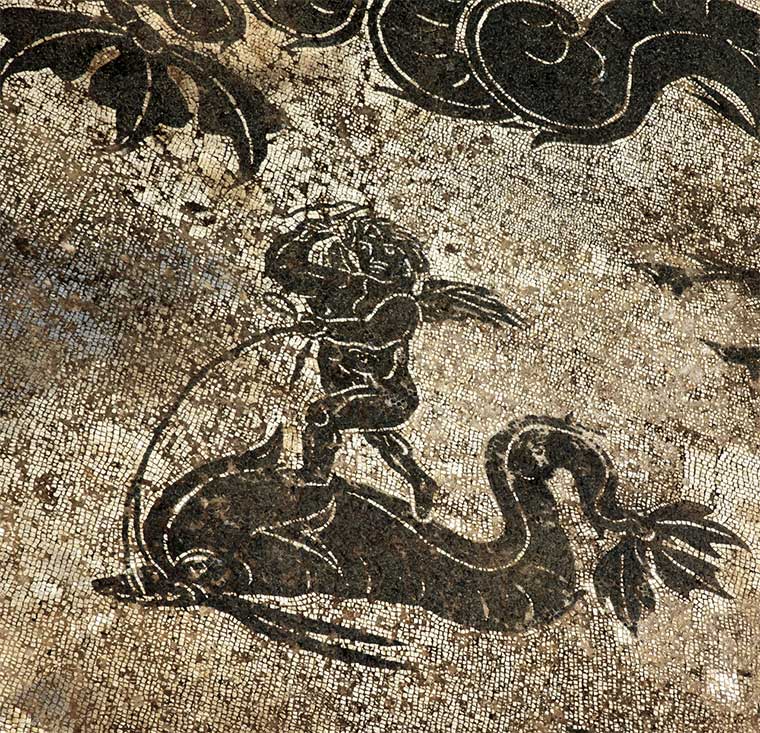
Ancient Roman Cupid Riding Dolphin Mosaic Floor Baths of Neptune Ostia Antica Ruins Rome Italy Excavation of Ostia, ancient Roman port, next to airport. Was po— Photo by billperry
So you’ll find the typical geometric patterns adorning the floors of baths whilst mythical characters decorate the floors of various houses. And you’ll also find entire pavements covered in mosaics indicating where rows of shops once stood. These were the original signs for traders selling to an illiterate population and today offer a fabulous insight into the shops, guilds and businesses that dotted the city. Look out for the exotic elephant that advertises the office of traders from Africa. It’s a great game to see how many you can find and decipher!
Ultimately Ostia Antica is a wonderfully tranquil, evocative place to visit and easily accessible as a train trip from Rome. And whilst rope rigging no longer slaps the sides of merchant ships bobbing in the harbor and no shoppers are bartering noisily in the shopping arcades it’s not hard to imagine a time when this coastal city was a hive of industry and trade. So next time you’re visiting the Eternal City, yearning for a break from the tourist clamour, take Metro line B to Piramide and hope on the local train line to Ostia Antica. You’ll discover a wonderful relic of the Romans, following in the footsteps of sailors and merchants. Just follow the ancient cobbled street, treading in the old cart tracks, and let yourself be transported back in time serenaded only by chirruping birds and clicking cicadas. You won’t be disappointed.
